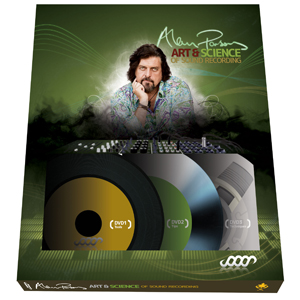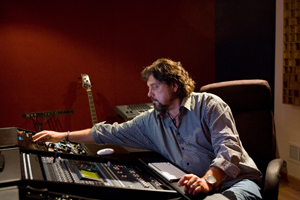On The Launch of “Art & Science,” Alan Parsons Talks Classic Techniques, Modern Apps, Concept Albums & Eye In The Sky
With his new web-based and DVD video series, The Art & Science of Sound Recording, acclaimed engineer, producer and musician Alan Parsons (Pink Floyd, The Beatles, The Alan Parsons Project) has created an enormous resource for recording musicians and both budding and experienced engineer/producers. In separate segments on essential topics like “EQ,” “Noise Gate,” “MIDI,” “Recording a Choir,” “Drums,” and “Studio Acoustics,” Parsons and other expert guests share techniques, and both historical and current best practices in the studio.
 Hosted and co-written by Parsons with Julian Colbeck, and narrated by Billy Bob Thornton, this series comprises many multiple segments, which Parsons is rolling out in blocks. 12 of the sections are available now for streaming (.99-per-segment) and download ($4.99-per-segment) at http://www.artandscienceofsound.com.
Hosted and co-written by Parsons with Julian Colbeck, and narrated by Billy Bob Thornton, this series comprises many multiple segments, which Parsons is rolling out in blocks. 12 of the sections are available now for streaming (.99-per-segment) and download ($4.99-per-segment) at http://www.artandscienceofsound.com.
Each segment runs between 20 – 30 minutes and delves deep into its subject matter — with applicable insight from producer/engineers like Jack Joseph Puig (Green Day, John Mayer), John Fields (Jonas Brothers, Jimmie Eat World), Sylvia Massey (Tool, Beck) and Tony Brown (Dixie Chicks, George Strait).
Parsons talks drums with Simon Phillips (The Who, Toto) and Taylor Hawkins (Foo Fighters), gets deep into MIDI with Dave Smith and Abbey Road’s Simon Rhodes, constructs a recording environment from scratch in Studio Acoustics, and actually sets-up/records a high school ensemble in “Recording a Choir.” Additionally, the latest wave of segments includes scenes covering Consoles and Controllers, Digital Audio and Computers, Monitoring, Microphones, Keyboards and Bass.
What makes The Art & Science of Sound Recording content so cool and potent, however, is the fact that viewers are being walked through the processes, tools, theory and thinking behind 60s, 70s and 80s-influenced modern studio practices by the studio master who engineered Dark Side of the Moon and founded the sonically inspired Alan Parsons Project. Awesome! We took this opportunity to ask Parsons about not only this series, but also the challenges facing experimental bands and producer/engineers today. Check it out:
What about right now inspired you to produce this series? And what were your big-picture goals for it?
We felt there was this huge gap between the recording tools people now had access to and the skills required to actually use them. A modern DAW with plug-ins can offer everything that was in studios like Abbey Road or Ocean Way — unlimited recording power, every processor known to man, mic and amp modeling — virtual everything, except knowledge and experience.
So the inspiration, and the challenge, was to try and find a way we could give people an insight into the now ‘classic’ tasks and techniques that I learned as a young engineer at Abbey Road and examine them within a modern environment.
You spoke with a lot of experts in the making of this series. Were there particular encounters where you actually learned something yourself, or discovered some new way of looking at a topic or technique? If so, what?
In more than 40 interviews I don’t think we ever had one awkward moment. Because I was the interviewer, everyone just wanted to ‘chat.’ They knew they could talk about anything and I would know what they meant, be it temperamental singers, A&R pressure, engineer/producer relationships, disasters… Everyone was incredibly relaxed and comfortable talking with a fellow professional.
I feel these interviews are quite unlike any audio interview that’s ever been conducted. Whether it was Sylvia Massey talking about drum mic phase inversion, John Fields talking about his use of the Pod, or Simon Phillips talking about putting large cans of sand inside his kick drum, there were many techniques that I may not necessarily use myself but that’s the beauty of recording. People have their favorite methodologies but there are few ‘definitive’ right and wrong ways of doing things.
Are there segments you consider really enlightening for professional producer/engineers?
Professionals are always going to be interested to see and hear what other professionals do. They may not necessarily ‘learn’ something in terms of learning how EQ works or how to calculate a tempo-synced delay — these things they probably have a pretty firm grasp of already — but what they will see, hear, and learn is how others approach a project; what are the really important decisions and where the effort really needs to be put in.
Sections of the program that will be particularly interesting at this level are “Mixing” and “A Live Tracking Session.” The “Recording A Choir” section goes into detail on the MS (Mid Side) technique, which not all engineers necessarily use on a regular basis. A lot of pros have already responded very well to the Drums section because Simon Phillips, who is such an accomplished and experienced drummer, gives such great insight into what goes into recording drums from a drummer’s perspective.
What do you think up-and-coming engineers and producers will get out of this series?
We hope that up-and-coming engineers and producers get a good idea as to what it was like recording in the classic era, when ‘erase’ was a totally destructive process and when ‘plug in’ meant literally that. It’s hard when confronted by limitless tracks, limitless cut, paste, undo and redo and limitless mixes, to know when to stop — the right time to say, ” That’s great. We’re done.”
We also feel that younger professionals, or potential professionals will appreciate how we don’t gloss over explanations or simply blurt out standard definitions. Many’s the time when we were writing the script we’d look at reference material to see how some technical term or process is generally described. Most times we’d end up almost crying with laughter as we had absolutely no idea what the author was talking about. Most technical audio explanations seem to be ten times more complex than the question. We really try to break things down into words that actually mean something.
Finally, we tried to tie old and new, analog and digital together. When talking about compressors or noise gates you can see me actually operating a physical piece of hardware and hear its affect on a piece of audio. Then I’ll do the same on a plug-in; compare and contrast, look at the relationship between them. The whole series is all about establishing a link between the origin of a tool or a technique and its modern day manifestation.
Next to the Alan Parsons Project, you’re probably best known for engineering “Dark Side of the Moon.” Looking back on those sessions with today’s perspective, what are the biggest obstacles you think a truly inspired, sonically experimental band faces today if they’re trying to make their own “Dark Side of the Moon”?
One of the problems in the digital age is the attention span of the listener. Back then we would bring home our shiny new “Concept Album” from the record store, put it on the turntable, turn down the lights, indulge in various other passions and just listen uninterrupted until it was time to turn the record over – and then on we went with Side 2. Now we have smart-phones, text messaging, countless TV channels, video games, the internet and so on. It’s a very 3-minute world out there right now. Experimental bands are more likely to get noticed playing live I think, although it’s true to say the internet can be a very powerful vehicle for promoting an act in the right hands.
And in what ways do you think today’s sonic frontiers promise even greater opportunities for creative expression in the studio? What artists and/or producer/engineers do you see currently pushing the boundaries?
Even with the technology explosion of the last few years, great music is still down to the performance and the song. Performances can admittedly be improved by technology, hence the incredibly widespread use of Autotune and Melodyne for example, but given talented players and good teamwork with a good producer and/or engineer you can rise above the technological BS that the equipment manufacturers will give you – implying that their product will turn your project into a hit. It’s about talent not technology. From Coldplay to Beyoncé I have pretty wide tastes — but I barely give a moment’s thought to what equipment they used for recording. But I am curious about the characters, the players and the thought processes behind the hits. In that context I’m just a listener like everybody else.
We recently did an interview with Robert Schneider of The Apples in stereo, who referenced your Eye In The Sky as hugely influential in his current quest for a retro-futuristic sound. What about the production of that album contributed to its “futuristic” sound?
First of all what a great accolade! Apart from the album at least attempting to be futuristic from a kind of Orwellian/Big Brother perspective, a number of emerging technologies may have contributed to the sound we achieved — sampling technology — The Fairlight, the Yamaha DX7 and digital mixing to name but a few.
Alan Parsons’ The Art & Science of Sound Recording will ultimately be available as a 3-DVD boxed set, as well as for ongoing download and streaming. According to Parsons, the goal of the series development is “to look towards a broadcast version and also to continue into the future with an ongoing website,” so take a look at the membership-subscription packages at http://www.artandscienceofsound.com. And follow Alan Parsons and The Art & Science of Recording on Twitter @ArtScienceSound – http://twitter.com/ArtScienceSound.
Please note: When you buy products through links on this page, we may earn an affiliate commission.







